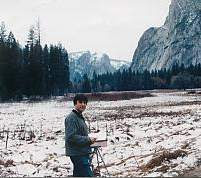





Hopefully those pictures are helpful. The next point is that one needs to be a goodly distance from the paper or canvas, as the size increases. I've seen artists trying to draw on an 18x24 paper while having their nose 10 inches from the sheet. You can't do this. To draw on a full 18x24 one needs to stand at arms length from the sheet to have any sense of accuracy. My illustration above show different placements. The sheet can be low or high but your vision should be square with the center of the sheet. It is practical to draw on a pad in one's lap up to about 14 inches high and one can hold it up to ones chin if drawing about 6 inches high.
If working really large on a canvas of greater that 30 inches, one will need to keep backing up a step or two to judge the drawing. There is, in essence, a perfect angle of view that and artist can effectively work in.
Another point I want to make is this: "Keep ones head level!" You can not accurately draw anything if you bend your head this way and that. You must keep your head level to the "drawing plane" when observing and level to the paper when drawing. This may seem like a "no brainer" but I can't tell you the number of students I've watched twist their heads first one way then the next.

This was informative. I sometimes get something off in a painting and wonder "what's up" when it doesn't look right. I've started using a mirror to my back to improve the outcome. I'll look at my work in this way as well, for more balance. Thanks..Cara
ReplyDeleteCara, You are welcome. You have given me an idea to talk about mirrors in a future blog. Paint happy!
ReplyDelete